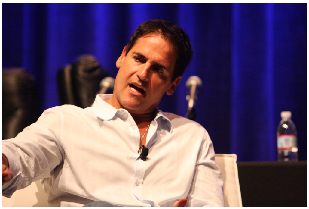It’s interesting to read that Mark Cuban was one of the earliest investors in the VIX. No, he did not conceive the index, and in the end the deal did not go through, but at least he created a demand for VIX derivatives. For the full story, click here

In the northern summer of 2002, newly minted billionaire Mark Cuban called Goldman Sachs looking for a way to protect his fortune from a crash. Because the VIX typically rises when stocks fall, he wanted to use it as insurance.
Devesh Shah, the Goldman trader who fielded the call, says he instead offered him an arcane derivative called a “variance swap,” but Cuban wasn’t interested.
Lamenting the lost opportunity, Shah met up with Sandy Rattray, a Goldman colleague and erstwhile indexing buff with a knack for packaging investment products. What if, the pair speculated, they could tap the VIX brand and reformulate the index based on their esoteric swaps? Turning the VIX into something tradeable was nothing more than a math problem, says Rattray.
The pair rewrote the VIX formula, expanding it to a larger universe of stockmarket bets and making it possible to create a tradeable futures contract. Their equation synthesises thousands of trades and distils them all into a single number meant to represent the collective expectations for the market.
Shah and Rattray handed their invention to CBOE, the owner of the VIX trademark. The formula allowed the CBOE to cash in its marquee index. The exchange launched VIX futures in 2004, and VIX options two years later. The firm billed VIX trading as a new risk-management tool. Trading grew steadily, but slowly.
Then the financial crisis hit, serving up a huge marketing opportunity — more than $US5 trillion was erased from the S&P500, the only thing rising in the US was the VIX. Who wouldn’t pay just a little bit more to protect their nest egg from the wipeout?
At Barclays, a farsighted few realised access was a big problem. Trading futures and options was too complicated and costly for many investors. The bank instead devised a product that tracks VIX contracts but trades on an exchange just like any a corporate stock. Suddenly anyone with a brokerage account could trade like the pros.
The Barclays iPath S&P500 VIX Short-Term Futures ETN launched in January 2009, just months before the S&P500 hit a 12-year low.
VIX trading exploded. Terrified investors piled into Barclays’s new product and similar ones that followed, desperate for anything that might help them repair their dented fortunes. “I think of it as the great democratisation of volatility,” says Bill Speth, vice-president of research and product development at CBOE.
So is trading the VIX a dangerous game?
The article ended with a quote from Bill Luby “If you knew the landscape, there was a lot of money to be made.”
ByMarketNews

No comments:
Post a Comment